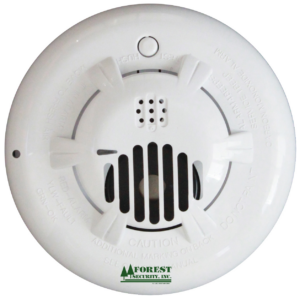Carbon Monoxide (CO) is a deadly gas that is emitted through burning fuels. The reason it’s so deadly is because it’s odorless, colorless and cannot be tasted. When people are exposed to it, they often don’t know until it’s too late. CO is emitted through burning wood, gas, propane and even oil from common appliances like dryers, ovens, fireplaces and cars.
Your first step in avoiding CO poisoning is to make sure that all of your appliances are being used correctly and in working order. A lot of leaks will come from a malfunctioning appliance, which allows CO to slowly seep into the air in your home. Make sure you have annual maintenance on your appliances to ensure that they aren’t doing more harm than good. 
Another huge cause of accidental CO poisoning is from your car’s exhaust pipe. Never start and idle your car when your garage is closed or you’re in an enclosed area. Additionally, always check to make sure that your exhaust pipe is not obstructed in any way. A blocked pipe can cause CO to emit into the interior of your car.
Now, in order to safely protect you and your family, there are a few things that you should know regarding CO and CO detectors.
What Are the Symptoms of CO Poisoning?
Perhaps the scariest thing about CO poisoning is that it closely mirrors cold and flu symptoms. After these are present for a period of time, the gas becomes lethal. The following symptoms are the beginning stages of CO poisoning and should be monitored closely if you suspect a leak:
- • Headache
• Dizziness
• Weakness
• Shortness of breath
• Nausea
• Tightness in chest
• Sleepiness
• Confusion
• Changes in vision
• Skin redness
Actions to Take if You Suspect CO Poisoning
The easiest way to differentiate CO poisoning from a cold or flu is when more than one person starts to show symptoms at the same time. If this occurs, it’s likely due to a CO leak. The symptoms may be present only in one area of your home and will get better if you move locations. If you notice this, leave your home so that you can breathe get fresh air. Leave the door open when you go outside and call 911 immediately.
How is CO Measured?
CO is measured in molecules by parts per million. So, 50ppm of carbon monoxide means that there are 50 CO molecules for every million molecules in the air1. CO poisoning can start low, sometimes even around 25ppm depending on exposure time. 
In order to avoid any possibility of CO poisoning, it’s important to use a carbon monoxide detector. In addition to saving lives, these detectors are actually required in homes and public places by many states. Most families don’t want to take the risk and will install them regardless of any statutes in place. If you want to read more about the current laws in your state, you can do so here. The good thing to remember is that if you have CO detectors installed in your home that are in working order, then you and your family can rest easy. The key to protection is effective detection.
Finding the Best Carbon Monoxide Detector For Your Home
Now that you know why it’s so important to install CO detectors in your home, you should educate yourself on the different models available. For a comprehensive CO detector that goes the extra mile, check out our CO detectors and sensors. Unlike most store bought detectors, the ones at Forest Security are monitored and linked with authorities. This means that if the alarm sounds and you’re too disoriented, or even unconscious, the police will be contacted immediately and authorities will come to your home. CO detectors that are monitored, like Forest Security’s Systems, will save your pet’s life if you happen to be away from home. Some other details to check out are:
Type of Power Source
Some CO detectors come with batteries and some are hardwired. There are equal benefits to both so it’s mainly just personal preference. Make sure that regardless of which power source you choose, you find something that is tamper-proof. The main difference between the two is that with battery powered CO detectors, your installation company will be able to place them around the house in areas that are optimal for detection, regardless of whether or not a power outlet is near.
Audible Alarm
When you’re shopping around, you’ll notice that some detectors might not come equipped with an audible alarm – rather, they’re interlinked with visual technology. The problem with this is that while you’re sleeping, you won’t be monitoring your Smartphone or tablet. Make sure that your detector has a loud alarm so you can know as soon as there’s danger.
Smart Technology
There are options for add-ons with certain CO detectors on the market. Two of which are a digital display and smart technology. A digital display allows you to visually monitor the levels of CO over time and smart technology allows you to wirelessly connect multiple alarms. These interlinking alarms can include smoke, heat as well as CO for integrated security.
After you purchase your CO detector they will last about 5 – 10 years if they’re properly maintained. The next step is figuring out where to install them for optimal monitoring and safety.
How Many CO Detectors Does Your Home Need?
When you make your purchase, it’s good to note that you should invest in more than one CO detector. This is because there are multiple areas in your home that the gas can come from. Make sure that you talk with your installation company to let them know how many CO detectors you’ll need installed. The professionals at Forest Security are here to help you purchase and install a detector in each of the following areas in your home:
- • On each floor of your home for maximum protection.
- • One near your garage. Since cars and other tools are a huge source of CO, it’s imperative that you have a detector nearby in case of any accidents or leaks.
- • One in the furnace room. If you have a furnace room, install a CO detector so that any leaks can be found before spreading to the rest of your home.
- • Make sure a CO detector is installed near any sleeping areas. CO poisoning that occurs while a person is sleeping can be fatal. Keeping a detector close is a great way to make sure that everyone can hear the alarm if it sounds.
- • Follow manufacturer recommendations. Each model is different so make sure you discuss any unique specifications with the Forest Security team.
- • Adhere to all local laws. Each state has different laws for CO detectors in homes. Read the laws for your state to make sure you are following them.
What to Do if Your CO Detector Goes Off
With all of your CO detectors in their places, the detection will be taken care of for you. However, what do you do when one of the alarms goes off? The main thing to do is remain calm. Make sure you get yourself, along with anyone else that’s in your home, outside and into the fresh air. As your gathering your family, open any doors or windows if you can and keep your door open when you go outside. Next, check yourself and your family for any symptoms that could indicate poisoning and call 911. Stay outdoors until your alarm stops or the respective authorities have deemed it safe. Finally, make sure you contact someone to come to your home and do an inspection of all of the possible sources of CO.
Case Study: Carbon Monoxide Detectors Save Lives
At the end of the day, CO poisoning is a scary thing to think about. It really does live up to its name as the “silent killer,” which is why it’s so important to have CO detectors in your home. Most people will never experience their CO detector going off, but if and when it does, it will save your life. In fact, just recently a family of 7 was saved due to proper CO detection. You can read all about their store here.
Action Steps
If you are looking to install a new CO detector, or simply update an old one, look no further than Forest Security. Our Smart CO Protection detector is wireless and powered by a 3V CR123A lithium battery for complete flexibility in placement. It emits an 85-decibel alarm so that you and your family can hear it throughout the entire house. With three LEDs that provide visual confirmation on the devices’ status, you’ll always know how it’s functioning. For more information, or a professional home and business security consultation, contact us today. We’re here to help you with all of your home protection needs. Check out our website at www.forestsecurity.com or give us a call at 708-452-2000.

